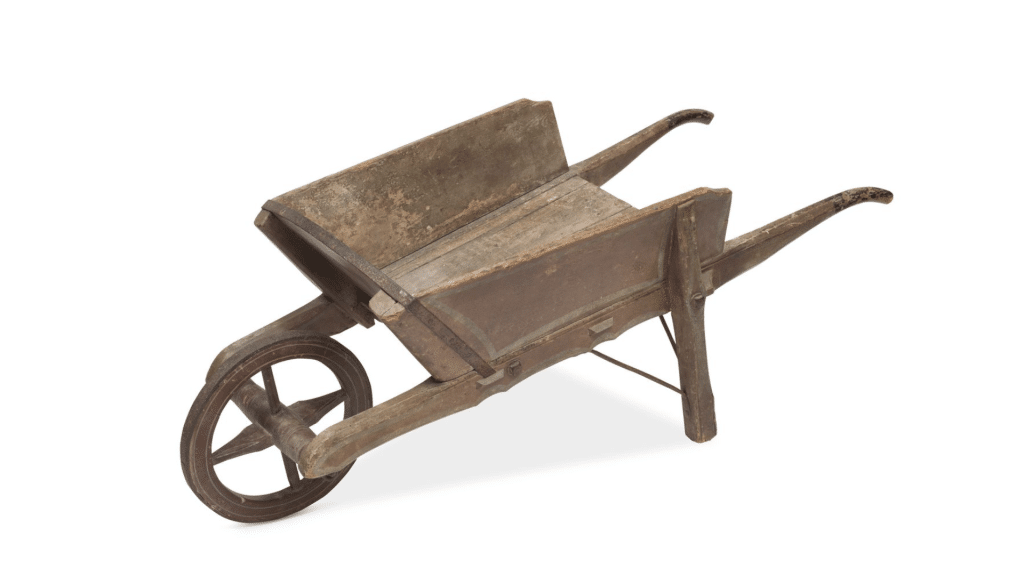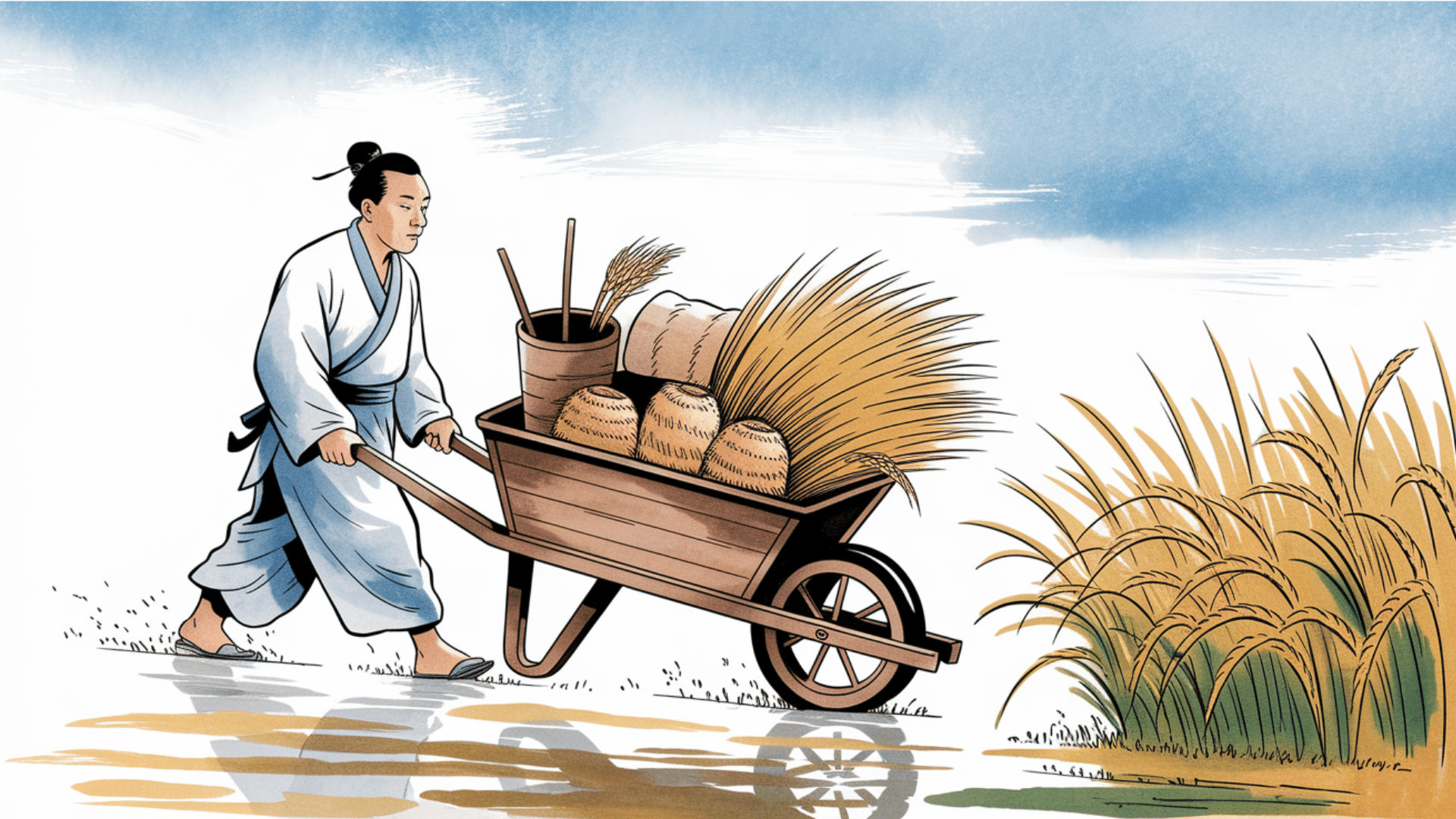The wheelbarrow is one of the simplest tools for moving heavy or awkward loads.
With a wheel, handles, and a tray, it allows one person to do work that might otherwise require two.
Today, it’s a common sight in gardens, on farms, and at construction sites. But its roots go back over 2,000 years, starting in ancient China.
This post examines its origins, evolution, and enduring relevance.
What is a Wheelbarrow and How Does it Work?
A wheelbarrow is a small cart with one wheel and two handles. It’s pushed by a single person and is used to carry things that are too heavy or bulky to lift easily.
It works by shifting most of the load onto the wheel, reducing the effort needed from the person pushing it.
Main features:
- One wheel (placed at the front or center)
- Two handles for control
- A tray or platform for items
This design allows for quicker and easier transport of materials over short distances.
Early Evidence in Han Dynasty China (100–200 CE)
The first reliable records of wheelbarrow use come from the Han Dynasty. These aren’t just written references; they include images carved into tomb walls.
One of the oldest examples is from a tomb near Chengdu, dated to 118 CE.
It shows a man pushing a one-wheeled cart. Another from around 147 CE also displays a similar device.
| DATE | EVIDENCE TYPE | FOUND IN |
|---|---|---|
| 118 CE | Wall painting | Tomb in Chengdu |
| 147 CE | Stone carving | Tomb in Sichuan |
Zhuge Liang and the “Wooden Ox” (231 CE)
In the Three Kingdoms period, military strategist Zhuge Liang needed a better way to move supplies through rough terrain.
Pack animals were noisy and slow, and carrying supplies by hand was inefficient.
He developed a version of the wheelbarrow known as the wooden ox and gliding horse. These had a centrally placed wheel that more effectively balanced the load.
What Made It Different?
- The wheel is placed at the center.
- Load balanced on the wheel, not the user
- Carried supplies for four men for one month
- Handled steep paths with just one person
This design helped troops move quickly and quietly, giving them an edge in rough terrain.
Everyday Use in Ancient China
Although it was first used for war, the wheelbarrow soon became a part of daily life in China.
Common uses included:
- Farming: Hauling harvests, tools, or water
- Construction: Moving stones, wood, and bricks
- Medical transport: Carrying the injured
- Trade: Bringing goods to markets
- Mining: Transporting ore, clay, or rock
With a wheelbarrow, one person could now do tasks that previously required two or more, saving time and labor.
Why the Chinese Design Was Effective
The key advantage of the Chinese design was the position of the wheel. Instead of placing it at the front, it was under the center of the load.
This meant:
- The wheel carried most of the weight
- Less strain was placed on the person
- It worked well on hills and narrow roads
- Loads could be larger without exhausting the user
This center-wheel setup made the tool more efficient for a wider range of tasks.
Did the West Use Wheelbarrows Before the 12th Century?
There’s no strong evidence that ancient Greeks or Romans used wheelbarrows.
A Greek document from the 5th century BCE mentions a one wheeled cart, but there’s no image or further record of what it looked like or how it worked.
In Rome, goods were typically moved by sleds, by hand, or in animal-drawn wagons. No device resembling a true wheelbarrow appears in Roman records.
In the 1170s, England saw its first clear example: a man pushed his paralyzed daughter in a wheelbarrow-like cart to St. Thomas Becket’s shrine.
This version had the wheel at the front. Unlike the Chinese design, it required the user to support more of the load, but it still offered a major improvement in labor efficiency.
It is unclear whether the idea was borrowed from Asia or created independently. Either way, China has the earliest confirmed use of the wheelbarrow.
Comparing Chinese and European Wheelbarrows
| FEATURE | CHINESE DESIGN | EUROPEAN DESIGN |
|---|---|---|
| First use | 100–200 CE | Around 1170 CE |
| Wheel position | Under the center | At the front |
| Weight support | Mostly on the wheel | Mixed (wheel + arms) |
| Terrain suited for | Mountains, paths | Farms, flat ground |
| Load size | Larger and easier | Smaller, more effort |
How the Wheelbarrow Design Spread
The Chinese wheelbarrow remained in use for centuries.
Its benefits spread to nearby regions like Vietnam, Korea, and Japan, where similar designs appeared, often with the same center-mounted wheel.
As trade expanded between Asia and Europe, the idea eventually reached the West. From there, the wheelbarrow became a universal tool for labor and transport.
In some rural areas of China, traditional versions are still used today.
Quick Facts Table
| TOPIC | DETAILS |
|---|---|
| Origin | China, Han Dynasty (100–200 CE) |
| Key innovator | Zhuge Liang (231 CE) |
| Main feature | Center-mounted wheel |
| Common uses | Farming, transport, trade |
| Reached Europe | 12th century CE |
| Still used? | Yes, in rural parts of Asia |
Final Thoughts
The wheelbarrow is a simple but lasting invention. First seen in ancient China, it allowed one person to move heavy loads with less strain.
Zhuge Liang’s improved design, with the wheel at the center, set a new standard for balance and ease of use.
Over time, the tool spread worldwide and adapted to different needs. Even today, some rural areas still use the traditional model.
Its long use proves that a well-made, practical idea can stand the test of time.
FAQs
Who First Used the Wheelbarrow?
Ancient Chinese workers during the Han Dynasty were the first confirmed users.
What Was the “Wooden Ox”?
A balanced, center-wheeled cart designed by Zhuge Liang to carry army supplies efficiently.
Did the Greeks or Romans Use Wheelbarrows?
No clear evidence exists. Only China has confirmed examples before the 1100s.
Why Is Wheel Position Important?
A center wheel holds more of the load and reduces the strain on the person pushing it.
Is the Original Design Still in Use?
Yes, in some rural regions of China and Southeast Asia, traditional versions are still found today.





















